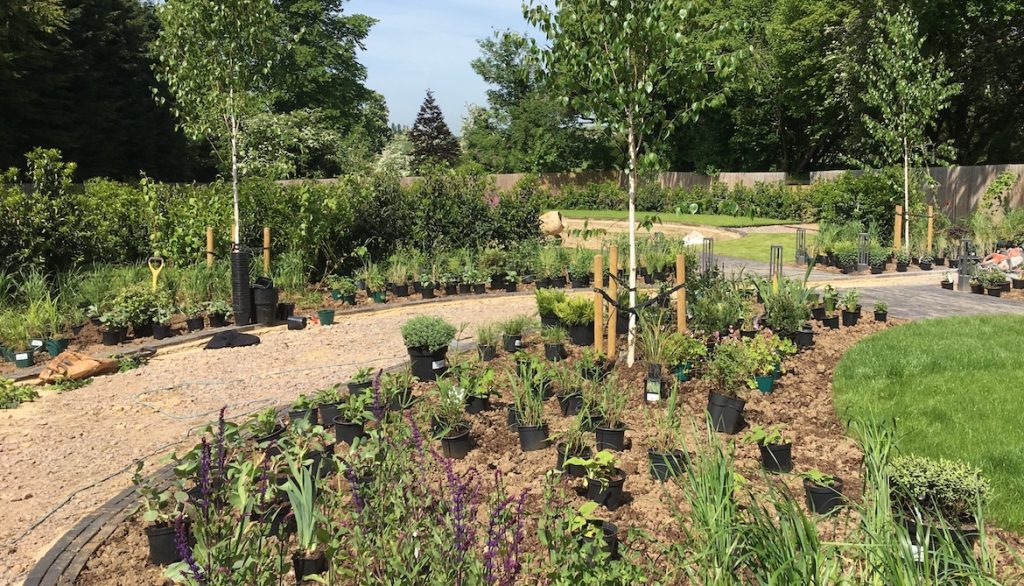You can also check our testimonials on our individual projects here to find out how we have successfully transformed outdoor spaces for people in a variety of settings!
FAQs
Whatever your situation, as garden designers, we can help you make your garden beautiful, useful and easy to maintain. As your garden designers, we would work with you and develop the design to suit your needs. So, if you love gardening, but want the layout to work better for your lifestyle, please get in touch.
If you enjoy gardening, you’ll love it even more when your garden has been re-designed exactly for you!
How long a garden takes to build will depend on the size of your garden and the complexity of the design. A small garden might take 4-6 weeks to build, but a larger one or more complex design will take much longer. This is something we would discuss at our first meeting.
We have mostly large gardens in our portfolio, but we can design any size of garden or part of a garden to suit our clients and fulfil the brief.
Although gardening and planting are seasonal, we do work all year round on the garden design. People often choose spring to rethink their garden, but we are happy to give you advice and guidance at any time. You can see from our Design Process pages that a lot of garden design is done indoors!
We generally plant in spring or autumn as the soil is usually more moist at these times of the year. But as long as the conditions are good and the plants are in stock, we will plant! Bulb planting is very seasonal, though; as bulbs need to be planted at the correct time of year for their species. E.g. tulips should be planted in mid to late autumn as they can be susceptible to ‘Tulip Fire‘ if planted too early . So, if we have planted a garden in spring, we will return in autumn to plant the bulbs.

Birch trees autumn leaves catching the afternoon sun – Amanda Broughton Garden Design
We also try to plant deciduous trees during the winter, and purchase them as bare root trees rather than in pots. During the winter, trees are dormant, so their water uptake is much less than during the growing season. This is a more economical way of buying trees as they are cheaper to buy and cheaper to plant.
However, to get to the planting… the design and hard landscaping will have been done. So we do the garden and landscaping design at all times of year.
Sourcing plants
Yes, absolutely, we can source plants! We offer a comprehensive sourcing and planting service for our design clients and will supply the plants you need to create the garden of your dreams.
This photo is of one of our planting days in the ‘Country Garden Design‘ in Hemel Hempstead.

Planting day in ‘Country Garden Design’ Herts.
Please go to our ‘Planting and Sourcing‘ page for more information about how we work.
You may be able to recoup the money you spend on your garden. Especially when it is well designed and enhances your property.
There are lots of reasons why garden design and gardening is worth the cost and effort:
• Your garden is an investment. A well designed garden could add up to 20% to the value of your house and make it more attractive to potential buyers. So, as with any home improvement, whether you can recoup the money or not will depend on what you do.

• Having your front garden re-designed, can help with the first impressions of your home and make the space more useful. See our Focus on front Gardens for inspiration.
• Also, if you have professional advice when choosing plants that are suitable to your soil and planting conditions, your garden will more likely establish and thrive.
• However it’s not just about the money; we provide a bespoke design service, so your garden fits your lifestyle and tastes. Whether you’re a keen gardener or keen to have a low maintenance garden, we can design a suitable garden for you. And with a garden you love, you’ll spend more time outside which brings other health benefits. So, you can’t lose!
Yes, we have a list of past customers who have been happy to act as references in the past and would be pleased to speak to you. If you would like to be put in touch with one of them, please call 020 8449 5781 and we will help arrange it.
We also have projects, photos and reviews on the home design site Houzz.
You can also check our testimonials on our individual projects. Have a look at our portfolio to find out how we have successfully transformed outdoor spaces for people in a variety of settings!
Wildlife Friendly Gardening
Here are some easy ideas for creating a wildlife friendly garden:
• The main tip for a wildlife friendly garden is to not keep it too tidy!
• Create a habitat pile out of fallen twigs rather than putting them in your green bin.
• Let shrubs grow down to the ground to create sheltered habitats for small mammals.
• Plant ground cover plants so wildlife can travel safely through the flower beds without crossing too much open ground.
• Choose hedges over fences: hedges provide shelter and allow small mammals to move freely from one garden to another. This is particularly good for hedgehogs and can be ideal for nesting birds too. Flowering and fruiting hedge plants e.g. Hawthorn and Blackthorn also provide pollen for bees and butterflies in spring and food for birds and small mammals in autumn.
• Leave a gap under fences; if you do put up a fence, leave a small gap underneath to allow Hedgehogs and other small mammals to move from one garden to another.
• Plant shrubs and perennials that are popular with pollinators. We all know about Buddleia being the ‘Butterfly Bush’ but did you know that bees and butterflies prefer simple flowers that are easier to get in and out of? Good plants for pollinators are Lavender, Borage, Scabious and Sage and lots of the spring bulbs too.
• Avoid using slug pellets; we don’t know for sure what the impact of slug pellets is on wildlife. But, as they reduce the slug and snail population, they reduce the food supply of the frogs, toads and hedgehogs. So if you allow the food chain to work naturally, slugs and snail numbers will be controlled by their predators.
Wildflower meadows
Another great way to attract wildlife is to create a wildflower meadow in an area of your lawn, insects love them! You don’t have to have a big garden to have a wildflower meadow, just an area that is not mown. Wildflowers generally prefer poor soil that doesn’t have too many nutrients, so it can be worthwhile to scrape the topsoil and grasses off the surface and add sharp sand or horticultural grit. This process will improve the drainage, remove some of the grass seeds and reduce the nutrient content of the soil.
Alternatively you can buy wildflower turf. This garden we designed in Hertfordshire has a turfed wildflower meadow:


Garden Design by Amanda Broughton
The colours change throughout the season depending on the plants in flower.
We have several wildflower meadows in our portfolio including: Office Garden, Barnet, and the one show above: Country Garden Design, Hemel Hempstead.
Ponds
Ponds come in all shapes, sizes and styles and you don’t have to spend a fortune to create one. Water creates habitats for a whole different set of wildlife, so will really expand the number of species in your garden. It’s sensible to buy a solar powered oxygenator or have oxygenating plants. Either way, they do need to be cleaned out regularly, especially during the summer to avoid stagnation.
Yes! We are currently involved in the design of two outdoor kitchens and looking forward to posting photos as soon as they are built.
Outdoor kitchens are becoming more and more popular and there are a huge range of products to choose from. Whether you envisage rustic garden living or a smart suburban lifestyle, there are designs and gadgets to suit you!
Very much like designing a kitchen, lots of it is about function. But, outdoors, there is often a bit more space to play with, so the seating and socialising areas need to be designed too. Also, the kitchen needs to integrate into the rest of the garden, so it all hangs together.
We are keen to build this part of our business, so please get in touch if you are planning an outdoor kitchen. We would love to help you with the design process!
There are a number of things to consider when you choose a Garden Designer:
Work you like
Obviously you will have searched the web for Garden Design inspiration. Keep a track of your research and create a shortlist of garden designers whose work you like the look of. You can also create a ‘Pinterest‘ board of your favourite garden design ideas.
Meet the designer
You will want to meet the Designer to find out who they are and how they work. Some Garden Designers charge a fee for an initial consultation and others don’t. Either way, you will need to meet them before going ahead, so if you are really keen on their work, you need the consultation.
Make the most of the Initial Consultation
You will get something out of this, even if you haven’t paid a fee. It is the Designer’s opportunity to demonstrate to you that they understand your needs. So they will likely start thinking about how the garden can be re-designed and possibly offer suggestions as it how they would translate your brief into a new design.
Assess the Quote and Brief
When you receive the designer’s quote you can decide if their fees are affordable. Also, they will write up your brief and you will be able to decide if they have interpreted it correctly.
A good working relationship
For a project to run smoothly, you need to trust your designer and have confidence in their ideas and professionalism. It is very important to have a good working relationship with them, built on mutual understanding and respect. Choose a designer who, while listening carefully to your brief, will also bring their own experience and creative flare and design a wonderful garden that fulfils your needs!
Location
Finally, if you choose a Garden Designer who has worked in your area, they may have garden designs that you can visit near by. Also, if you have planning applications to be submitted, the designer will have experience of dealing with your local authority.








